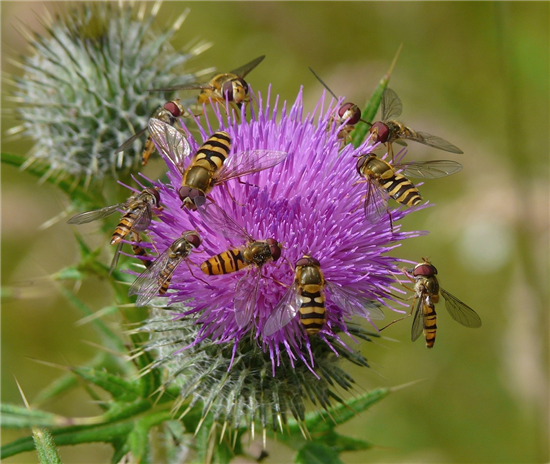A Ranger writes
Countryside Ranger Richard English shares his knowledge of hoverflies.
Wild animals adopt a variety of lifestyles and techniques to avoid predators and other threats. These often take the form of ‘fight or flight’ reactions – either standing and defending themselves or taking to their heels (assuming they have heels, that is). One alternative strategy is known as mimicry and effectively involves hiding in plain sight. In mimicry, a harmless animal displays the outward signs (such as colouration and behaviour) of a much more threatening species. Plants can also display mimicry, as demonstrated by the number of non-stinging species (dead-nettles, hemp-nettles, hedge woundwort etc.) that will lurk, safe from grazing animals, within nettle patches.
 Assorted hoverflies Abbie Marland
Assorted hoverflies Abbie Marland
An example of mimicry in the insect world comes in the form of hoverflies. There are about two hundred and fifty species of hoverfly in the UK, in a variety of shapes and sizes. What they have in common is their colouration – they are generally yellow and black, and bear more than a passing resemblance to bees and wasps. As a result, hoverflies gain a measure of protection against predators such as birds (and can also cause terror amongst small children). All this despite the fact that hoverflies have no sting whatsoever and are essentially defenceless. Some species have even evolved to mimic the stinging action of wasps and, if threatened, will thrust their back end towards its attacker, despite the absence of a stinger.
One species, Volucella bombylans (catchy name), has taken things a step further. The female lays her eggs in the nests of bees and wasps, and once the young hatch they live there as scavengers, feeding on debris and sometimes even on the larvae of their hosts. Hoverfly larvae generally can be very useful things to have around, as many of them feed on garden pests such as aphids.
One of our commonest hoverflies is Episyrphus balteatus, which is also known as the much more easily remembered ‘marmalade hoverfly’. They have the characteristic orange/yellow and black colouration and can be found in large numbers gathered around flowers, in order to feed on nectar. They are important pollinators, as indeed are most hoverfly species.
 Marmalade hoverfly Lynne Kirton
Marmalade hoverfly Lynne Kirton
Despite their frail appearance, marmalade hoverflies are a migratory species, with many individuals overwintering in southern Europe and northern Africa. Others, especially adult females, will brave the elements, remaining in northern areas over the winter months.
Another common species worth looking out for is Helophilus pendulus. The name is Greek and can be vaguely translated as ‘hanging marsh lover’ and perhaps reflects the species’ fondness for damp habitats. Like many hoverflies, its larvae are aquatic and can be found in lakes, ditches, ponds and puddles. It’s also known as the sun fly, which is probably due to a mistranslation of the scientific name – helo meaning ‘marsh, but helio meaning ‘sun’.
 Helophilus pendulus MJ Richardson
Helophilus pendulus MJ Richardson
This species is a little bigger than many hoverflies and has distinctive black and yellow vertical stripes on its thorax (although other closely related species also show these). These stripes have led to this hoverfly also being known as ‘the footballer’, suggesting that whoever came up with name was a supporter of East Fife or Berwick Rangers.